A few posts ago I mentioned that perhaps people were less interested in reading about my predominately Burda sewing and I was happy to receive lots of feedback which was in two categories. Those who sew already from Burda and are happy to see patterns made up, and those who are just interested in my sewing, whatever the pattern. I got to thinking - perhaps there is a third category - people who would like to try Burda magazine but are not sure how the patterns work.
If you are interested or just want to get an explanation of those pattern sheets, read on! Here are a few of my favorite Burda patterns.

Diving in, here is the pattern I've decided to use an an example of how to find and trace. I don't know if I will get around to making it, and I like the ruffle version ( which is 104) but it might just be a bit too ruffly for me. It's Pattern 103 from the May 2020 issue. They generally mention having one designer pattern, I suppose from a German designer, the one in this issue is really pretty and perfect if you like the statement sleeve look.


First thing I always look at is the "All Styles at a Glance" pages. It shows you the line drawing for each item, categorized by dresses, tops, pants, etc. I refer to these constantly! In fact I have the Russian end of year summary page bookmarked on my iPad and in idle moments when I want to make something I scroll through and look at various months (which I have looked at a zillion times already) and often find just what I had in mind! They also have a double page at the front which is the photos of all the patterns, but I find the line drawings so much more useful to look at. Look at all those cute dresses - when will I get time for those ?
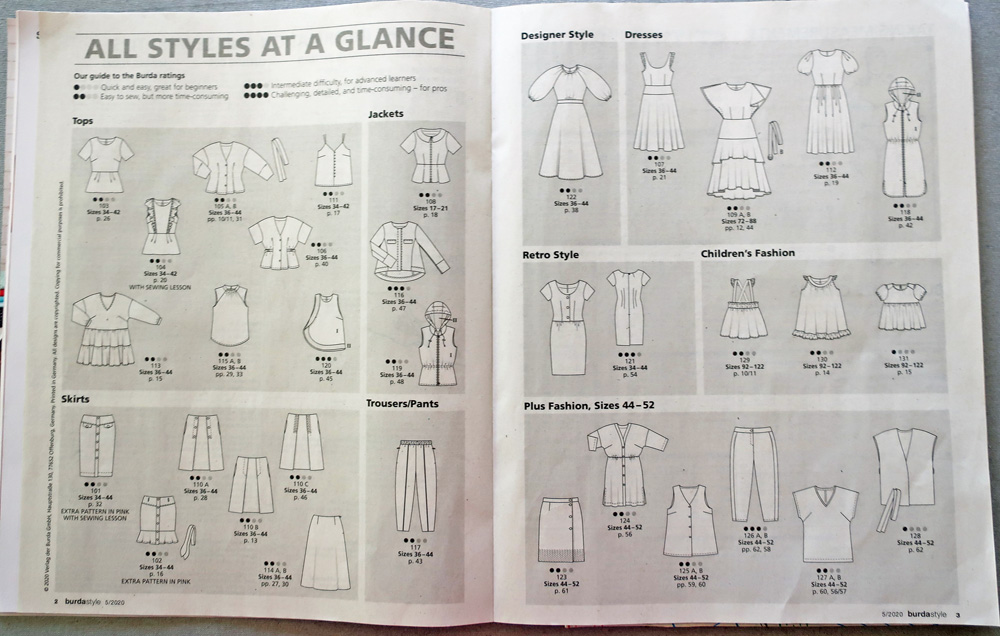
Once I've decided on what to sew, then the task of tracing starts. The pattern drawings, size info, yardage and cutting, plus the instructions are then in the following pages. Yes - the instructions are sparse but after a couple of years I've realized that they are reasonable complete and if you've traced the markings they provide then they work.
Here's the detail for this pattern No. 103 Blouse. It shows front and back line drawing, tells you which pattern sheet to find it (Sheet D, red lines), and the sizes available plus tracing lines for each size. It gives you the diagram of the pattern pieces (showing grainlines and notches) and then yardage requirements. It tells you how many to cut of each pattern piece and whether on the fold. Then the instructions follow. As it happens for this pattern the cutting layout is continued on the next page in the magazine so I couldn't get it into this photo, but it's there, see the next photo.


I do find it useful to look at the cutting layout, whether or not I plan to use it because invariably - and this applies to any pattern brand - I sometimes overlook a pattern piece and realize that when I see the cutting layout.
The next step is to unfold the pattern sheet and find the Sheet D. They come as one very large sheet, with Sheet A and B on one side and Sheet C and D on the other side. They indicate a cut line in the middle and I alway cut into two sheets as shown which are a lot easier to manage.

Then I run a dry iron over the pattern sheet. I find paper irons so well, I iron all patterns I get, as it makes them easier to work with, and takes away all those little folds and crumples that will change the measurements. At this point don't panic about the jumble of lines you see on the sheet.


Here's sheet D, and we'll be looking for Red pattern pieces. Each sheet has the Month/Year on the sheet which is handy as I tend to separate them from the magazine (unintentionally) and if they weren't labeled that would be a problem.
Next step is to circle all the pattern piece numbers that I'm going to trace. All the pattern piece numbers for an individual pattern are on one side of the sheet. I keep the magazine instruction sheet on my work surface and just go down the list of pattern pieces. I find it helpful to go in order, as it just works to make sure you get them all circled.
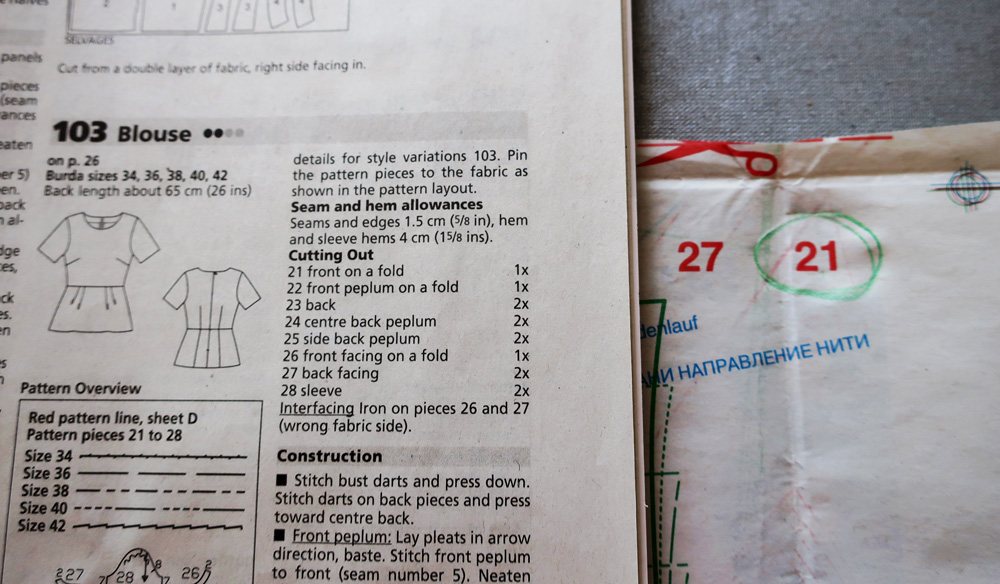
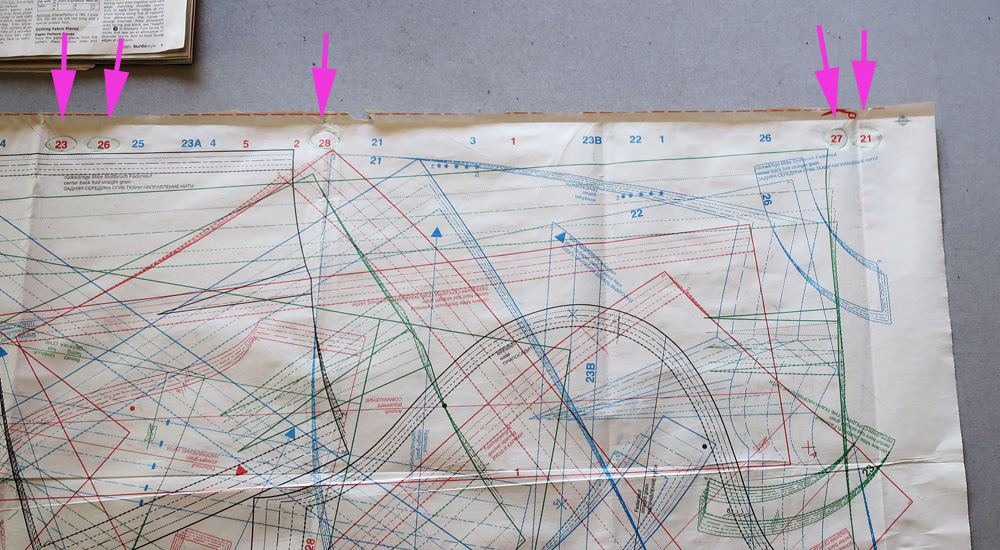
So here they are, circled and ready to find and trace. Note that on that edge of the pattern sheet there are other red numbers (I see numerals 5, 2 and 1) which indicates there is another pattern with red lines also on this sheet. It may look like a jumble at this point but there is a bit of method to the way the whole thing is printed - stay with me.
Now here's the thing that one day I realized (and Burda veterans probably laughing at me now). The pattern piece number on the edge is DIRECTLY above the pattern piece number in the sheet. So you can just go straight down until you hit the number, and then there is the pattern piece. I'm not saying it's always easy to find the whole pattern piece outline, but this really helps. Also the pattern piece number is generally along the bottom or center fold of the pattern piece, so that's another help. They put the number in a spot that is not along a size variation edge. Here I've outlined in yellow our pattern piece 28, with the number 28 along the bottom edge. I've also shown Blue pattern piece 3 highlighted in green, and you can see that piece is straight below the numeral 3. Puzzle - can you see where 26 and 5 are straight below their edge numbers?

Now let's zoom in this pattern piece 28, which happens to be the sleeve. I've shown it here on the sheet, and then outlined it yellow. After a while the pattern pieces start to jump out at you, once you get the pattern piece number located in the middle of the sheet. I find that the other colors of pattern pieces tend to recede in my mind and I am focus on the ones I am looking for. It's a bit like doing a puzzle - which is quite the popular pastime these days, right?

I think everyone is accustomed to tracing patterns, or at least has done it a few times with an expensive pattern. It's a matter of finding the size lines and tracing. The important thing with Burda is to make sure and catch all the notch markings, although there aren't a lot.
My number one tip for tracing is to pin the tracing paper to the pattern sheet, in two places. The reason for this is that it can't then shift when you are tracing and mess up all your work.

Burda is fairly minimalist in their pattern markings but they always include grain line, a notch for the front armhole/sleeve, pleats and gathers, and then some numbers which at first eluded me but now I realize are invaluable.
Here I'm tracing the front bodice, it has a single notch which matches a notch in the sleeve. Also there are tiny numbers in various places on the pattern, they are found inside the smallest size of the pattern piece. Below the pencil you can see a tiny numeral 6.
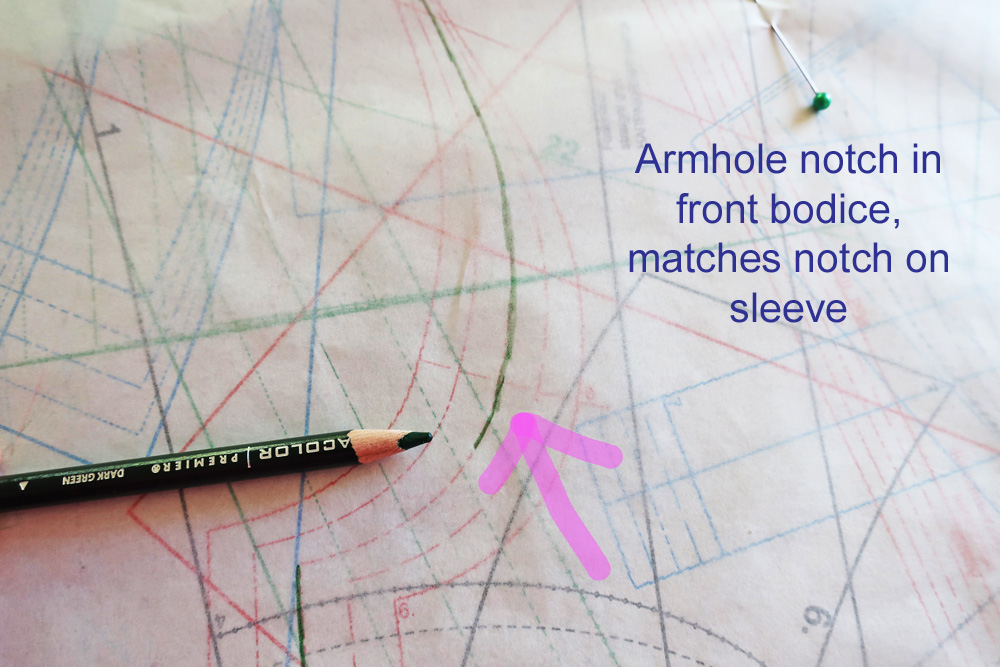
This next picture shows the importance of these little numbers, and why I always put them on my pattern pieces now. Basically they are a little connect-the-dots system! Honestly I kind of kicked myself when I realized how that worked, as I was able to sew the patterns together but this makes it so much easier to figure out which pattern piece is which and where they go. I've put some little color spots to show the system. They are indicated in the instruction page and I now find them so valuable.
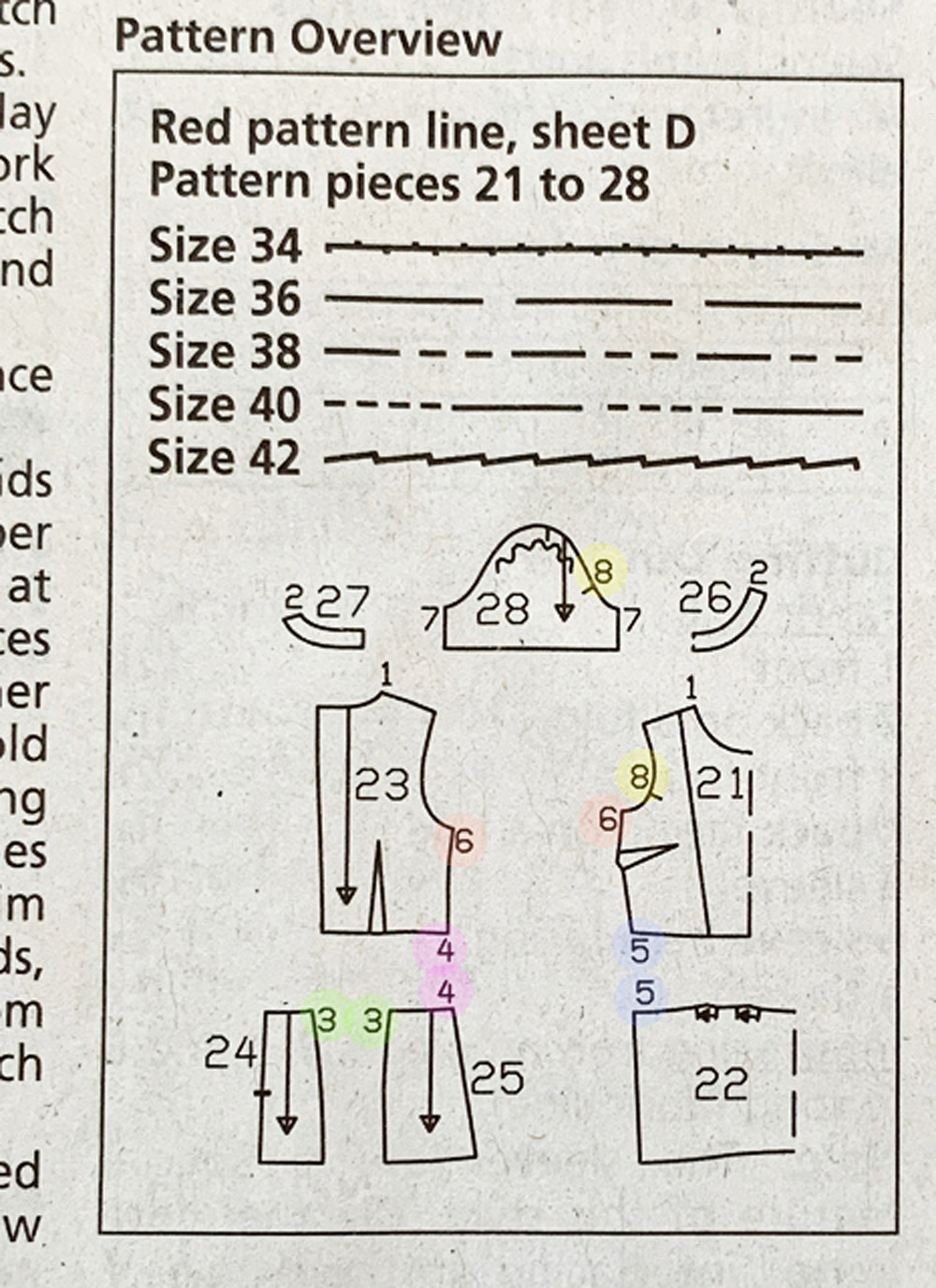
I also find it very helpful to use the landmark of the center front or center back/straight grain which is noted in several languages so it's easy to find that little paragraph and work out where the pattern piece is from that starting point.
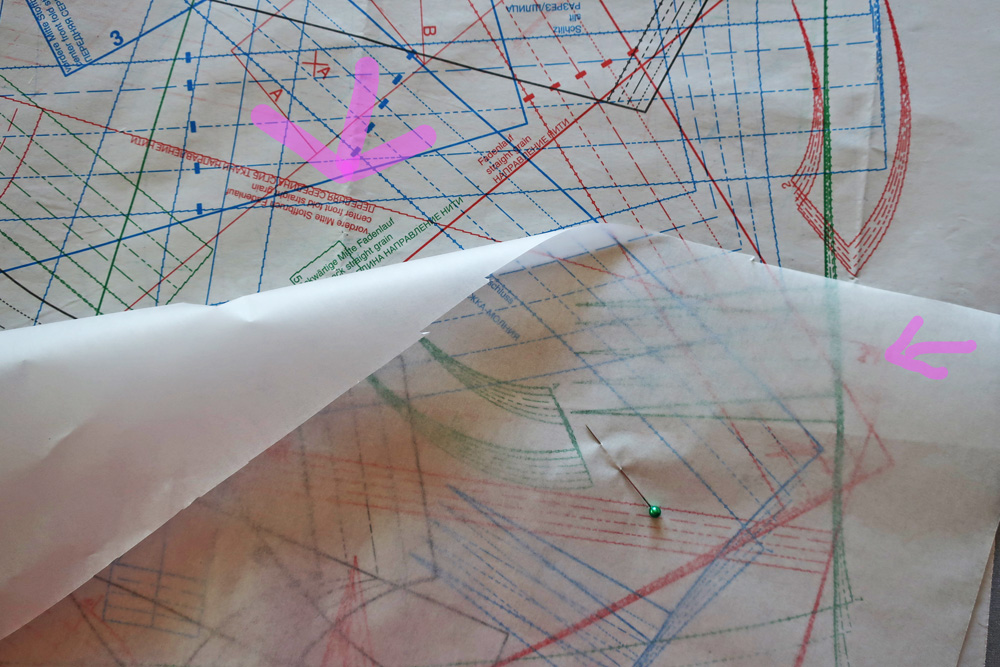
One last thing I forgot to photograph, is that as I trace each pattern piece I put a line through the circled edge number, so that I know I've found/traced it and don't end up duplicating my work.
This is what I end up with. I haven't mentioned adding seam allowances - so I will talk about that plus alterations in a separate post. For each pattern piece I write the size I traced, the Piece #, the Month and Year, and any other info I might think of. Also I mark all those little numbers which in my head I call the "join numbers". I've marked these in Sharpie markers so you could see them but usually I use colored pencils which work so well with tracing paper. Plus I end up color coding some of my subsequent alterations.
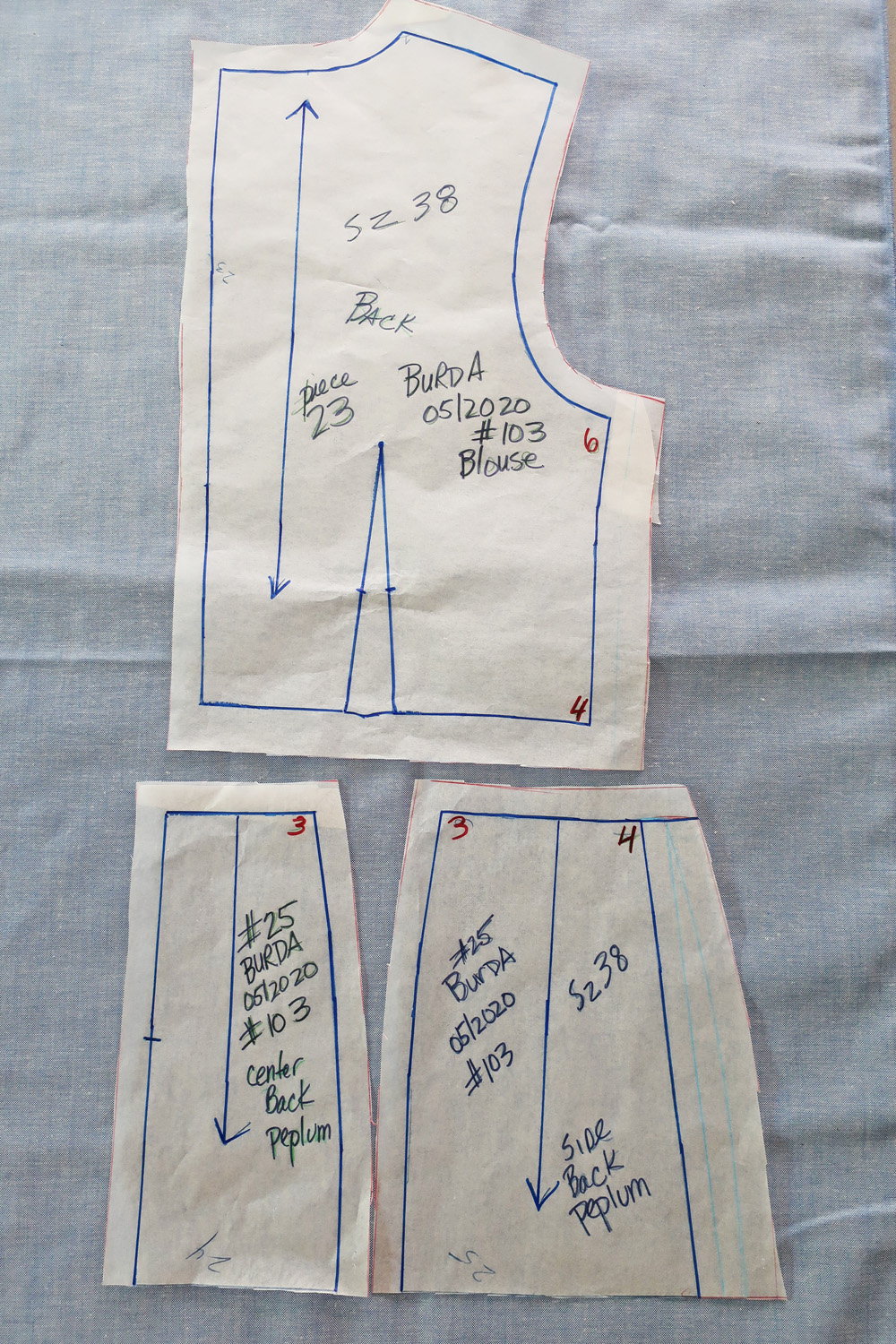
So that's the scoop on tracing a Burda magazine pattern. As I mentioned, some people might know all this info but most of it I kind of figured out as I went. I would have been happy to have someone tell me all about how to do it :)
Up next, I have finished my denim blazer with matching jeans and looking forward to wearing it despite knowing that it is a... lot of look! I just made some Megan Nielsen Flint shorts, lengthened to be more like culottes and I they are going to be a useful addition to my wardrobe. Despite not needing anything I have succumbed to quarantine boredom and ordered some fabrics which have turned out to be lovely so I'm looking forward to sewing and wearing.
It was 102℉ here today - scorching and it's only May! Fortunately I did a lot of garden work the past two weeks because that's on hold until we cool down a bit.
I hope everyone is well and making it through these strange times. Keep on sewing and posting and I will to - it's been a wonderful distraction to have so many sewing friends around the world making beautiful things.
Happy Sewing,
Beth
today's garden photo - the roses were gorgeous a couple of weeks ago when they put out the big spring bloom. This yellow one is next to the grape which is growing like wild this year and I will hopefully have some grapes in a few months. Plus I picked two zucchini this morning. Time to make some grilled vegetable pizza I think.












Beth, this is the very best explanation of Burda magazines I have ever seen and I would have found it invaluable when I started my own Burda journey in 2012 but like you, discovered along the way. One thing with so many magazines [I have every one since 6/2012] in my library is finding a particular pattern. Can you explain where the Russian Year end site is that you mentioned please? You have inspired me to make several Burda items, thank you.
ReplyDeleteNot Beth but . . . This is the "Russian site : https://burdastyle.ua/encyclopedia/anatomiya-modeli/tehnichni-malyunky
ReplyDeleteAt least, it's the one I know and use.
Thank you - that's great. I will cut 'n' paste to make a catalogue. This is going to make finding a pattern SOOOOoooo much easier.
DeleteThat's the Ukraine site! The Russian site has a .ru extension. But it has the most reviews and makes it easy to get to the magazines! If you use Chrome, you can auto translate the pages.
DeleteBrilliant Beth.
ReplyDeleteI have just one further suggestion. I remove the centre pages from the magazine and place them in a large envelope, labelled with the month and year. I then store the traced patterns in the envelope too and write on the front of the envelope which traced ones are 'inside'. I have a LARGE collection Burda magazines now and it helps keep me/them organized!
Thank you Beth, it makes it so clear. In the past I used to use Burda patterns but only recently come back to them. I did not know anything about the small numbers and in fact ignored them, so that is great tip of the day.
ReplyDeleteThat's nice overview. I learned sewing with burda (at a time when the patternsheet was a lot more crowded) so it never scared me. I think burda compares to Ikea instructions: Nothing unnecessary but all information given is important.
ReplyDeleteJulia
Beth, thank you for this post. It gives me the courage to trace and try a pattern from a magazine. How do you find the Burda magazines?
ReplyDeleteYou are a great inspiration to me to get me back to my machine, and I always enjoy the lovely flower from your garden, at the end of your post.
Not Beth, but I have seen them at JoAnn on the magazine rack, that is, assuming you are writing from the US.
DeleteThank you,R.
DeleteI echo everything here. This is what I do to trace Burda (and other magazine patterns) as well.
ReplyDeleteI've been sewing from Burda magazines since the 1980s. This is a good summary of the process. I've found the Russian Burda website more accessible than the new English site for looking up pattern style diagrams, but haven't come across the end of year summary page. That would be really useful. Can you provide the link?
ReplyDeleteHi, here is the link to the summary page I use. Scroll down and you will see each month's issue tech drawing.
DeleteIf you click on that month it takes you to a page of that month where you can see each pattern in more detail. Also at the bottom of the web page there are links to the previous years, I can't read Russian :) but I could see that it showed 2018, 2017 etc. and that's what it is.
https://burdastyle.ru/tehnicheskie-risunki/burda-style-2019-vse-tehnicheskie-risunki_22051/
Beth,
ReplyDeleteI first started sewing with Burda magazine when I lived in Europe for many years. I love it. The styles are generally terrific and I find the fit works well with my body. But I've not been able to find an address for a subscription to the magazine here in the US. Do you have one that you might share? Thank you so much for your posts. Love he flowers.
Hi, thanks for reading. I subscribe via a company called Roltek. They took over for GLP which was a German language magazine provider that closed last year. if you search for them you get their website in Canada, the invoice I have was from a Roltek office in Buffalo NY. so they are definitely shipping to US. their email is service@roltek.com so you could email and order a Burda English subscription, which was $99/yr for my order.
DeleteThank you for your excellent explanations and illustrations for how to use Burda magazine patterns. I have an issue that I picked up a couple of years ago that I haven't had the courage to tackle. The magazine has some garments that I would love to try for the fall/winter, so I will be watching for your next posts about adding the seam allowances and alterations.
ReplyDeleteBeth, thank you so much for this priceless explanation. I now have the courage to buy the latest magazine and tackle a pattern or two! The instructions look sufficient, if you have had some experience with garment making. I was concerned about that part, as well as all of those lines, but your step-by-step diagrams proves seeing only what is needed and visually ignoring the rest is something we can all get the hang of, with a little practice.
ReplyDeleteMy comment did not seem to register, so I try as anonymous instead. One thing that I wonder is why english speaking sewists add seam allowance when they trace? Here where I live (sweden) the most common thing seems to be to trace and cut the pattern pieces and then mark the fabric with tailors chalk (or tacks) for desired seam allowance, the other option is to line out the sew lines and go wild with the allowance. What is your preferred with for the seam allowance? My preference is 1 cm.
ReplyDeleteNot Beth but can I ask: When you add seam allowances to the fabric prior to cutting, do you match the cut lines when you sew or the marked seam lines?
DeleteHere in North America, we've been taught to match the cutting lines so that's why we add the seam allowances to our patterns. We cut with the fabric folded, right sides together. Any markings (darts, etc) are usually traced onto the wrong sides of the fabric.
If Europeans match the stitching/seam lines, can you explain to us how you do that. It seems like it would be a lot more difficult, particularly when setting in sleeves and such. Or, do you mark the stitching/seam lines on the right side of the fabric? Do you cut single or double layer?
I add seam allowance when I trace as I prefer to have the pattern piece exactly as I would cut it out, so I can just pin on fabric and cut. I think drawing the seam allowance on the fabric would be difficult on a printed fabric. I add 5/8" because that is just what I am used to, growing up with American sewing patterns they always have a 5/8" seam allowance (mostly) so I just find that easier to sew. Also it gives a bit of wiggle room for small fit adjustments. Also - to answer the reply above - I don't match the cut lines when I sew, I match the stitching lines which is what makes the pattern pieces sew together correctly. I visualize where the stitch line is on each piece and match that together, it does take a bit of practice to train your eye to see where that stitch line should be.
DeleteI sew a lot of Burda too and sometimes I do this as you describe - I add it on the fabric. Rare and usually if I don't plan to remake it. Also, more likely to do it with a knit tee or something - I'll eyeball a 1/4" allowance :)
DeleteBut with most patterns, it's more helpful to me to have a complete pattern.
Thank you for the post, I'm just starting to think about sewing.
ReplyDeleteSo you post are always great to read.
Thank you : )
Thanks for this explainer! I have been sewing with Burda since living in Europe in the 80's-and I never caught that joiner number detail. duh. I have a good collection now, in various languages. Sheltering at home is a good time to dig through my collection for something cute!
ReplyDeleteBeth, Thank you for taking the time to talk about your process. I have made many Burda Style patterns but found this information very valuable. Happy Sewing!
ReplyDeleteI really appreciate your explanation on how to use Burda Magazine patterns. I've only ever traced and sewn one. It turned out fine, but I'm sure tracing materials are much better now. I'd be curious to know what kind of tracing paper you used and where to find it. Thanks.
ReplyDeleteI use a specific type which I found a few years ago at Staples but now order online from the big "A" Search for Bienfang tracing paper (that's the brand) and it comes in rolls in a variety of widths. It's the most see-through and yet sturdy tracing paper I have found. Sometimes it's also listed as Artist's Tracing paper.
DeleteThank you so much! I do know what you are talking about.
DeleteExcellent post, Beth! My first contact with sewing patterns was with Burda, back in the 80s 😊. I am also an avid collector of their magazines (I own most issues from 2004 on plus a few gems from the 80s and 90s). My most prized issues are the Burda International, no longer in print. Happy sewing!
ReplyDeleteWhat a great post! I have been curious about Burda patterns for a while and your post gave me alot of good information. Thank you for helping us "newbies"!
ReplyDeleteThanks for the tips, Beth. I've not sewn Burda but those sheets are similar to the ones in Ottobre magazines, though Ottobre have fewer garments per issue. One thing I learned to do is to highlight my pattern pieces with a Frixon pen before covering it with the tracing paper. It makes the lines easier to see and a light iron erases them, making the pattern sheet unmarked and ready for tracing any other pieces without confusion.
ReplyDeleteThis is a Great post Beth! :-)
ReplyDeleteMy first Burda magazine was from 1999. I started subscribing a couple of years later. I collect them and I often use older patterns and combine to knock off garments that I like. That's often the best part of owning almost 20 years of magazines. I use the same method of tracing and I tend to use a different color to mark my sizes. I honestly find it a lot easier than PDF patterns. I really love their coats and jackets.
ReplyDeleteI've been using Burda for many years but never thought of pinning the tracing paper to the pattern sheet. I've always used a cup, apple or tin :D and then it would invariably shift a little bit. Thanks for that!
ReplyDeleteNot sure if it's available in US but I get Burda tracing paper here in EU. There are 5 sheets in a pack, each one as big as the double pattern sheet (before separating A and B). It's very light, just a little heavier than big4 patterns but it feels sturdy. One side is shiny so you can use markers on that side and the other is a bit rough and works well with pencils. When I started sewing I was tracing using large clear plastic bags, the heavy kind that you can pin and try for fit.
Thank you Beth. Very helpful. I appreciate it.
ReplyDeleteBeth, thanks for the tutorials on the Burda tracing. I have lots of the magazines but haven't traced too many of the patterns. I'll use your tips and see if it goes faster. Question - off topic - with Bluprint shutting down, will you be able to make your tutorials available on your blog? I have referred back to many of them so was hoping there would still be access to them somehow. They are very clear and easy to follow. Thank you!
ReplyDeleteThanks for mentioning that - I am looking at those and thinking about doing them as posts on my blog so they will be retained.
Delete